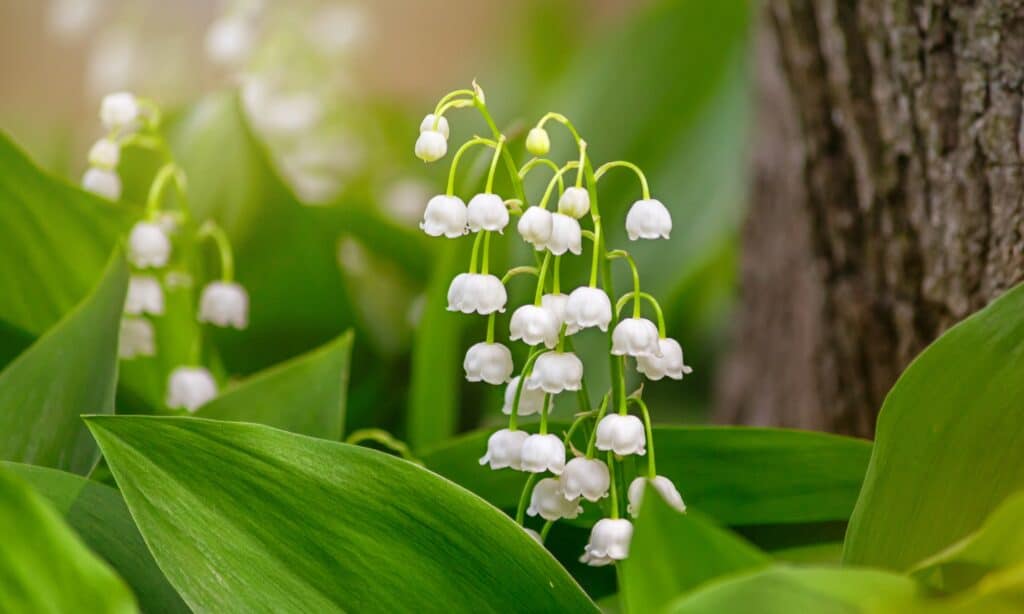Beautiful and incredibly fragrant, lily of the valley bulbs have been seen in gardens since ancient times when early recordings of the Bible and similar manuscripts mention the plant. They’re not true lilies, but they do offer similar features, such as the fragrance and lovely blooms and foliage, and they happen to be the national flower of Finland.

The Convallaria majalis which is most commonly known as the “lily-of-the-valley” just happens to be Finland’s national flower.
©iStock.com/rustamank
| Botanical name | Convallaria majalis |
| Popular varieties | Rosea,Albomarginata, Albostriata, Aureovariagata, Crema da Mint, Hardwick Hall, Fernwood’s Golden Slippers, Bordeaux, Flore Pleno, Fortin Giant, Dorien |
| Light needs | Lily of the valley bulbs love partial to full shade |
| Water needs | Regular watering without getting soggy |
| Soil needs | Slightly acidic to neutral is preferred, but lily of the valley does fine in almost any soil, even clay, as long as it is well-drained |
| USDA Hardiness Zones | 3 to 9 |
| Beginner friendly? | Yes |
| Special care notes | They should contained, else they’ll spread! |
What Are Lily of the Valley Bulbs?

Lily-of-the-valley will grow best in dappled sunlight and cooler climates, such as those found in its native habitats in Europe and North America.
©Viacheslav Rubel/Shutterstock.com
Lily of the valley bulbs grow beautiful flowers on spiky stems, but they’re not true lilies. In actuality, these stunning plants belong to the asparagus family, as do some other popular flowers like bluebells and muscari (grape hyacinth). Known botanically as Convallaria majalis, the plant produces white to pink blooms with yellow to green accents, depending on the variety. Fragrant, prolific, and leafy, the plants also produce orange-red berries in autumn. In some cases, they are considered an invasive species and the fruits, flowers, and all other parts of the plant are toxic to both humans and animals.
What Are Lily of the Valley Bulbs Used For?
While they need to be placed carefully because of high toxicity levels, lily of the valley plants are often chosen to plant natural gardens and container gardens, particularly on pet-free patios. And being shade lovers, they are often chosen as indoor plants, as well, as they may be more easily kept in healthy condition without excessive or precise lighting.
Varieties or Types of Lily of the Valley Plants

In Finnish culture, the lily-of-the-valley is a symbol of love and purity. Its sweet, small, and pretty blossoms make it popular for picking from the wild or including in bouquets.
©Cholpan/Shutterstock.com
Several varieties of lily of the valley plants may be available in your local nursery. The most well-known is the common lily of the valley (Convallaria majalis), which has dark green leaves and tiny white, fragrant blooms. These are the iconic little bell-flowered plants most of us think of when we hear the name lily of the valley.
Some other lily of the valley plants include:
- Rosea, a pink flowering cultivar
- Albomarginata, which has white edges on pink
- Albostriata, with white stripes on pink
- Aureovariagata, displaying yellow or bright green stripes
- Crema da Mint, featuring bright green stripes
- Hardwick Hall, sporting green stripes
- Fernwood’s Golden Slippers, showing off yellow foliage
- Bordeaux, a tall variety
- Flore Pleno, a tall variety with double flowers
- Fortin Giant, reaching up to 18 inches in height
- Dorien, with larger than usual flowers
How to Care For Lily of the Valley Bulbs

While the lily of the valley plant looks beautiful in bloom, it produces poisonous berries.
©Klymenko Mariia/Shutterstock.com
Light Requirements
One reason lily of the valley bulbs are popular among beginner and casual gardeners is because they thrive in a range of light situations. Plant them in partial shade to full shade or areas with dappled light. They love everything but direct, full sun. If you do need to plant them in full sun, be sure to provide some shade cloth or other forms of shade to protect the plants.
Water
Like most bulb flowers, lily of the valley plants are not fans of soggy soil and may develop root rot if over watered. Instead, keep the soil moist, allowing the soil to only slightly dry out between waterings.
Soil Conditions
Organically rich, well-draining soil is the right choice for planting your lily of the valley bulbs. They’re not terribly picky about anything else in the soil, including clay content. They do prefer acidic to neutral pH but aren’t terribly picky.
Fertilizer
Unless planted in poor quality soil, lily of the valley bulbs need no fertilizer, helping to make them a great choice for beginners and busy folks. If the soil isn’t great, you may add some slow-release granular fertilizer in the spring before flowering.
How to Propagate

The beautiful flowers pop in vivid white on bold, spring green stems.
©Agnes Kantaruk/Shutterstock.com
A natural spreader, lily of the valley plants are exceptionally easy to propagate; the issue would be more likely whether or not you can prevent it from spreading.
To propagate:
- In spring or autumn, gently dig up clumps of lily of the valley with a hand trowel of small shovel.
- Gently tug apart the roots and separate sections of the plants from each other.
- Find a shady location and plant the newly separated bulbs about 6 inches apart from each other.
- Water the soil thoroughly and maintain moisture levels until the plant goes into dormancy.
The photo featured at the top of this post is © iStock.com/rustamank
Thank you for reading! Have some feedback for us? Contact the AZ Animals editorial team.






